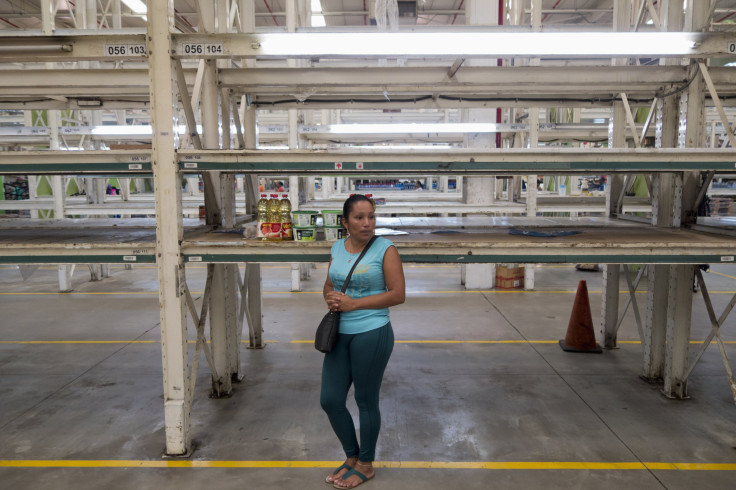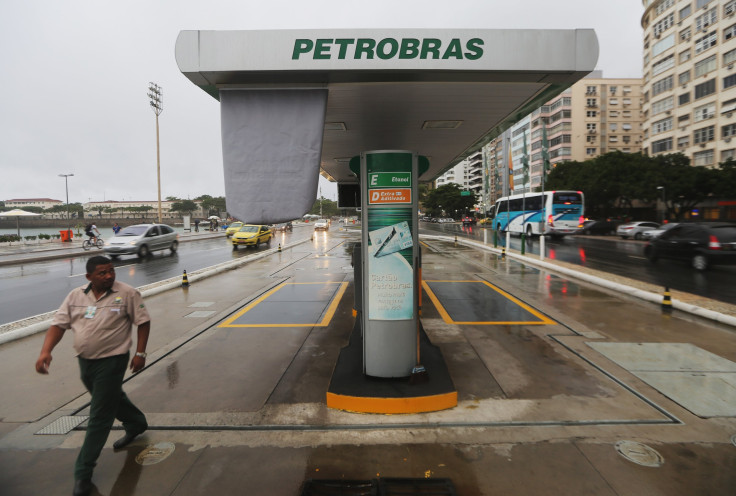How The World's Biggest Oil Exporters Are Suffering From $40-A-Barrel Crude Oil

Oil-rich nations are reeling from the latest drop in crude oil prices, which plunged to six-year lows Monday on rising fears of an economic slowdown in China, the world's largest energy consumer. Weaker Chinese demand is threatening to further depress prices and strain the governments that are most dependent on oil revenues to fund their public budgets and pay off foreign debts.
Oil prices have fallen almost 60 percent since last summer due to a widening market imbalance. Tepid economic growth in China and Europe is curbing the global appetite for crude, which is in overly abundant supply. U.S. producers are partly driving the glut, with American oil production nearing record levels in 2015. Saudi Arabia is further straining the market, as the kingdom and other OPEC members refuse to dial down their output. Such a move would help raise oil prices but threaten their share of the Asian markets.
Brent crude, the global benchmark, plummeted to $42.51 a barrel Monday, its weakest level since March 11, 2009, after China cut its benchmark interest rate for the fifth time in nine months -- an attempt to jump-start its sluggish economy. U.S light crude dropped to $38.24 a barrel, its weakest since February 2009.
Prices recovered slightly Wednesday as markets rebounded from Monday’s stock scare. Brent crude was up 0.37 percent to $43.37 per barrel as of 7:56 a.m. EDT. U.S. light crude gained 0.51 percent to $39.51 per barrel.
Oil-reliant countries with large foreign exchange reserves and broader borrowing abilities will be able to endure the economic strain in the short term. But governments without strong financial buffers are being forced to make dramatic cuts in their reserves and go deeper into debt, leading to weaker currencies, rising inflation and tightening public budgets for infrastructure projects, food imports, education spending and state employee salaries.
"Every government that's heavily dependent on oil revenue, either as a share of income or export revenues, is having to respond in some way," said David Goldwyn, president of Goldwyn Global Strategies LLC, an energy consulting firm. "At $40 a barrel, everybody's budgets are underwater, and some quite dramatically. It's increasing the fiscal deficit and requiring countries that were already facing low growth to suffer even higher pressures."
Goldwyn was the State Department special envoy and coordinator for international energy affairs in the first Obama administration. He said the current oil prices raise "a red flag" for political tensions and civil unrest throughout the oil-producing world. "You look at the countries that are fragile to begin with" -- such as Iran, Yemen, Libya, Venezuela and Nigeria -- "and then you short them money, and that's where you have to watch the stability issues," he said.
Here’s a look at how four major oil-producing countries have been slammed by cheaper crude:
1. Venezuela

Venezuela relies on crude sales for roughly 96 percent of its exports, and more than half of the country’s gross domestic product. Venezuelan economists estimate that for every dollar off the price of oil, the government loses as much as $700 million in estimated revenues a year.
As a result, Venezuela is acutely exposed to any dip in oil prices, and the country is facing an economic crisis. Foreign reserves plummeted to a 12-year low in late July, reaching just $15.3 billion, down from a 2015 peak of $24.2 billion in late February.
Behind on billions of dollars in debt it owes for imports, Venezuela is quickly running out of basic supplies. About one-third of staple food items are missing from conventional store shelves, according to a survey of 60 items by Cenda, a Caracas-based investigation group. Vital health services -- including chemotherapy and antiretroviral drugs for HIV patients -- are shrinking, prompting protests outside hospitals and in the streets.
President Nicolás Maduro’s government estimates it needs oil prices at well over $100 a barrel to break even on its budget. But energy experts don’t expect oil prices to reach triple digits at all this year, prompting gloomy forecasts for Venezuela.
The International Monetary Fund says it expects the Venezuelan economy to shrink by 7 percent this year. Barclays analysts see the country’s inflation reaching 200 percent this year, although official estimates are unavailable. The Maduro government stopped publishing monthly inflation data in December, when the annual level hit 68 percent, the highest in the world. The central bank similarly has refused to report balance-of-payment or GDP figures this year.
2. Nigeria

Like Venezuela, Nigeria gets nearly all of its exports and foreign exchange earnings from petroleum, with about 70 percent of the federal revenue coming from crude oil sales.
Falling oil prices are eating away at the country’s Excess Crude Account, into which Nigeria saves the difference between market oil prices and its budget benchmarks. The account, which offers a cushion when prices fall or the nation needs extra infrastructure funding, now holds just over $2 billion, down from a 2012 peak of $8.7 billion, according to Nigeria’s Ministry of Finance.
Nigeria, Africa’s largest oil producer, needs oil prices at $119 a barrel to balance its budget. Without those revenues, the oil sector has shrunk by 8.2 percent, the National Bureau of Statistics estimates. Construction on public infrastructure projects has stalled, and government workers across the country have seen their salaries withheld, sparking concerns of instability.
Pressure is mounting on the Nigerian government to slash consumer subsidies for imported gasoline, heating oil and other refined products. Nigeria spent 20 percent of its 2013 budget on fuel subsidies, said Emmanuel Kachikwu, the head of Nigeria's state oil company, who called the program "unsustainable" given current oil prices.
Cheaper crude also is battering the country’s currency, driving inflation past 9 percent and hampering its foreign reserves. The naira has weakened by 7.8 percent against the U.S. dollar this year. Nigeria’s gross dollar reserves were down to $31.6 billion on Aug. 18, an 8.8 percent drop from $34.4 billion in December, according to the Central Bank of Nigeria.
3. Russia

Russia’s economy is less reliant on petroleum than Venezuela's or Nigeria's, but the nation still is suffering from falling prices. Moscow gets more than half its budget revenue from oil and gas, and for every $10 drop in the per-barrel price of oil, Russia loses up to $14.6 billion a year in revenue by some estimates.
The slump in crude prices, combined with Western sanctions over Moscow’s role in the Ukraine crisis, have pummeled the Russian economy in recent months. Russia’s currency, the ruble, took a particularly hard hit Monday amid the stock market mayhem spurred by China. The ruble traded Monday as low as 71.04 to the U.S. dollar, its lowest point this year, after sliding by 23 percent in the last 30 days.
Russia’s foreign currency reserves have dropped by more than $140 billion since the start of 2014, to about $360.5 billion. While that’s enough to help Russia hedge some of the effects of cheaper crude, Russia’s central bank is aiming to reach a “comfortable” level of up to $500 billion to help Russia weather its economic recession, bank officials said in June.
Russia’s GDP is expected to shrink by up to 4 percent this year. The nation could endure a two-year economic contraction if crude prices don’t surpass $60 a barrel through 2016, the Central Bank of Russia has estimated.
The drop-off in Russia's growth will have ripple effects across the Caucasus region, said Goldwyn, the energy security expert. "In the Middle East and Africa and Central Asia, the neighboring economies are highly dependent on those oil exporters for jobs or remittances," he said. The workers and residents dependent on oil-exporting countries for income "are going to be impacted, because the jobs in those countries, or the remittances, are going to shrink dramatically."
4. Brazil

Brazilian leaders initially had counted on Petrobras, the state-owned oil and gas giant, to offset the pain of lower oil prices by boosting production and profits. That didn’t happen.
Petrobras this summer lowered its long-term production target to just 2.8 million barrels per day by 2020, down from an earlier target of 4 million. The company also announced plans to divest $15.1 billion in assets in 2015-2016, plus another $42.6 billion in assets in 2017-2018. Petrobras is grappling with colossal debt of around $124 billion on top of billions of dollars in penalties related to an ongoing corruption scandal at the energy giant.
Meanwhile, low oil prices are eating away at the company’s bottom line. Petrobras reported net income of $150.2 million for the second quarter of 2015 -- down nearly 90 percent from the same quarter in 2014. Analysts had projected a decline of about 20 percent.
Petrobras’ struggles have large implications for the Brazilian government, which depends on oil export revenues to pay for education and infrastructure programs. The energy company is Brazil’s biggest source of investment, and its sales were equal to 6 percent of the country’s GDP last year.
Brazil’s economy is forecast to shrink 2 percent this year, while inflation in the last 12 months reached 9.57 percent.
© Copyright IBTimes 2024. All rights reserved.





















